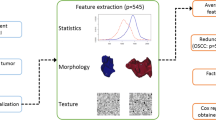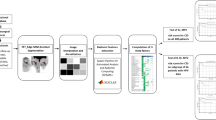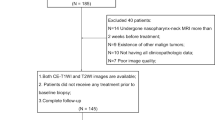Abstract
Objectives
To externally validate a pre-treatment MR-based radiomics model predictive of locoregional control in oropharyngeal squamous cell carcinoma (OPSCC) and to assess the impact of differences between datasets on the predictive performance.
Methods
Radiomic features, as defined in our previously published radiomics model, were extracted from the primary tumor volumes of 157 OPSCC patients in a different institute. The developed radiomics model was validated using this cohort. Additionally, parameters influencing performance, such as patient subgroups, MRI acquisition, and post-processing steps on prediction performance will be investigated. For this analysis, matched subgroups (based on human papillomavirus (HPV) status of the tumor, T-stage, and tumor subsite) and a subgroup with only patients with 4-mm slice thickness were studied. Also the influence of harmonization techniques (ComBat harmonization, quantile normalization) and the impact of feature stability across observers and centers were studied. Model performances were assessed by area under the curve (AUC), sensitivity, and specificity.
Results
Performance of the published model (AUC/sensitivity/specificity: 0.74/0.75/0.60) drops when applied on the validation cohort (AUC/sensitivity/specificity: 0.64/0.68/0.60). The performance of the full validation cohort improves slightly when the model is validated using a patient group with comparable HPV status of the tumor (AUC/sensitivity/specificity: 0.68/0.74/0.60), using patients acquired with a slice thickness of 4 mm (AUC/sensitivity/specificity: 0.67/0.73/0.57), or when quantile harmonization was performed (AUC/sensitivity/specificity: 0.66/0.69/0.60).
Conclusion
The previously published model shows its generalizability and can be applied on data acquired from different vendors and protocols. Harmonization techniques and subgroup definition influence performance of predictive radiomics models.
Key Points
• Radiomics, a noninvasive quantitative image analysis technique, can support the radiologist by enhancing diagnostic accuracy and/or treatment decision-making.
• A previously published model shows its generalizability and could be applied on data acquired from different vendors and protocols.




Similar content being viewed by others
Abbreviations
- AUC:
-
Area under the curve
- CRT:
-
Chemoradiotherapy
- DSC:
-
Dice similarity coefficient
- HD:
-
Hausdorff distance
- HPV:
-
Human papillomavirus
- ICC:
-
Intraobserver correlation coefficient
- LRC:
-
Locoregional control
- MRI:
-
Magnetic resonance imaging
- OPSCC:
-
Oropharyngeal squamous cell carcinoma
References
Fruehwald-Pallamar J, Hesselink JR, Mafee MF, Holzer-Fruehwald L, Czerny C, Mayerhoefer ME (2016) Texture-based analysis of 100 MR examinations of head and neck tumors - is it possible to discriminate between benign and malignant masses in a multicenter trial? NMR Biomed. 188:195–202. https://doi.org/10.1055/s-0041-106066
Bos P, van den Brekel MWM, Gouw ZAR et al (2021) Clinical variables and magnetic resonance imaging-based radiomics predict human papillomavirus status of oropharyngeal cancer. Head Neck. 43(2):485–495. https://doi.org/10.1002/hed.26505
Yu Y, He Z, Ouyang J et al (2021) Magnetic resonance imaging radiomics predicts preoperative axillary lymph node metastasis to support surgical decisions and is associated with tumor microenvironment in invasive breast cancer: a machine learning, multicenter study. EBioMedicine. 69:103460. https://doi.org/10.1016/j.ebiom.2021.103460
Aerts HJWL, Velazquez ER, Leijenaar RTH et al (2014) Decoding tumour phenotype by noninvasive imaging using a quantitative radiomics approach. Nat Commun. 5:4006. https://doi.org/10.1038/ncomms5006
Mes SW, van Velden FHP, Peltenburg B et al (2020) Outcome prediction of head and neck squamous cell carcinoma by MRI radiomic signatures. Eur Radiol. 30:6311–6321. https://doi.org/10.1007/s00330-020-06962-y
Bos P, van den Brekel MWM, Gouw ZAR et al (2021) Improved outcome prediction of oropharyngeal cancer by combining clinical and MRI features in machine learning models. Eur J Radiol. 139:109701. https://doi.org/10.1016/j.ejrad.2021.109701
Guha A, Connor S, Anjari M et al (2020) Radiomic analysis for response assessment in advanced head and neck cancers, a distant dream or an inevitable reality? A systematic review of the current level of evidence. Br J Radiol. 93:20190496. https://doi.org/10.1259/bjr.20190496
Granzier RWY, Ibrahim A, Primakov SP et al (2021) MRI-based radiomics analysis for the pretreatment prediction of pathologic complete tumor response to neoadjuvant systemic therapy in breast cancer patients: a multicenter study. Cancers. 13:2447. https://doi.org/10.3390/cancers13102447
Song J, Yin Y, Wang H, Chang Z, Liu Z, Cui L (2020) A review of original articles published in the emerging field of radiomics. Eur J Radiol. 127:108991. https://doi.org/10.1016/j.ejrad.2020.108991
Park JE, Park SY, Kim HJ, Kim HS (2019) Reproducibility and generalizability in radiomics modeling: possible strategies in radiologic and statistical perspectives. Korean J Radiol. 20:1124–1137. https://doi.org/10.3348/kjr.2018.0070
Jethanandani A, Lin TA, Volpe S et al (2018) Exploring applications of radiomics in magnetic resonance imaging of head and neck cancer: a systematic review. Front Oncol. 8:131. https://doi.org/10.3389/fonc.2018.00131
Rai R, Holloway LC, Brink C et al (2020) Multicenter evaluation of MRI-based radiomic features: a phantom study. Med Phys. 47(7):3053–3063. https://doi.org/10.1002/mp.14173
Mayerhoefer ME, Szomolanyi P, Jirak D, Materka A, Trattnig S (2009) Effects of MRI acquisition parameter variations and protocol heterogeneity on the results of texture analysis and pattern discrimination: an application-oriented study. Med Phys. 36(4):1236–1243. https://doi.org/10.1118/1.3081408
Wahid KA, He R, McDonald BA et al (2021) Intensity standardization methods in magnetic resonance imaging of head and neck cancer. Phys Imag Radiat Oncol. 20:88–93. https://doi.org/10.1016/j.phro.2021.11.001
van Velden FHP, Kramer GM, Frings V et al (2016) Repeatability of radiomic features in non-small-cell lung cancer [18F]FDG-PET/CT studies: impact of reconstruction and delineation. Mol Imaging Biol. 18:788–795. https://doi.org/10.1007/s11307-016-0940-2
Ibrahim A, Refaee T, Leijenaar RTH et al (2021) The application of a workflow integrating the variable reproducibility and harmonizability of radiomic features on a phantom dataset. PLoS One. 16(5):e0251147. https://doi.org/10.1371/journal.pone.0251147
Leijenaar RTH, Carvalho S, Hoebers FJP et al (2015) External validation of a prognostic CT-based radiomic signature in oropharyngeal squamous cell carcinoma. Acta Oncol. 54:1423–1429. https://doi.org/10.3109/0284186X.2015.1061214
Leijenaar RTH, Bogowicz M, Jochems A et al (2018) Development and validation of a radiomic signature to predict HPV (p16) status from standard CT imaging: a multicenter study. Br J Radiol. 91:2017049811075. https://doi.org/10.1259/bjr.20170498
Zhai TT, Wesseling F, Langendijk JA et al (2021) External validation of nodal failure prediction models including radiomics in head and neck cancer. Oral Oncol. 112:105083. https://doi.org/10.1016/j.oraloncology.2020.105083
Romeo V, Cuocolo R, Ricciardi C et al (2020) Prediction of tumor grade and nodal status in oropharyngeal and oral cavity squamous-cell carcinoma using a radiomic approach. Anticancer Res. 40:271–280. https://doi.org/10.21873/anticanres.13949
Yuan Y, Ren J, Shi Y, Tao X (2019) MRI-based radiomic signature as predictive marker for patients with head and neck squamous cell carcinoma. Eur J Radiol. 117:193–198. https://doi.org/10.1016/j.ejrad.2019.06.019
Martens RM, Noij DP, Koopman T et al (2019) Predictive value of quantitative diffusion-weighted imaging and 18-F-FDG-PET in head and neck squamous cell carcinoma treated by (chemo)radiotherapy. Eur J Radiol. 113:39–50. https://doi.org/10.1016/j.ejrad.2019.01.031
Martens RM, Koopman T, Lavini C et al (2021) Multiparametric functional MRI and 18F-FDG-PET for survival prediction in patients with head and neck squamous cell carcinoma treated with (chemo)radiation. Eur Radiol. 31:616–628. https://doi.org/10.1007/s00330-020-07163-3
van Griethuysen JJM, Fedorov A, Parmar C et al (2017) Computational radiomics system to decode the radiographic phenotype. Cancer Res. 77:e104–e107. https://doi.org/10.1158/0008-5472.CAN-17-0339
Dice LR (1945) Measures of the amount of ecologic association between species. Ecology. 26(3):297–302. https://doi.org/10.2307/1932409
Huttenlocher DP, Klanderman GA, Rucklidge WJ (1992) Comparing images using the Hausdorff distance. IEEE Trans Pattern Anal Mach Intell. 15(9):850–863. https://doi.org/10.1109/CVPR.1992.223209
Johnson WE, Li C, Rabinovic A (2007) Adjusting batch effects in microarray expression data using empirical Bayes methods. Biostatistics. 8(1):118–127. https://doi.org/10.1093/biostatistics/kxj037
Fortin JP, Cullen N, Sheline YI et al (2019) Harmonization of cortical thickness measurements across scanners and sites. Neuroimage. 167:104–120. https://doi.org/10.1016/j.neuroimage.2017.11.024
Warnat P, Eils R, Brors B (2005) Cross-platform analysis of cancer microarray data improves gene expression based classification of phenotypes. BMC Bioinform. 6:265. https://doi.org/10.1186/1471-2105-6-265
Hanley JA, McNeil BJ (1982) The meaning and use of the area under a receiver operating characteristic (ROC) curve. Radiology. 143:29–36. https://doi.org/10.1148/radiology.143.1.7063747
Baeßler B, Weiss K, Dos Santos DP (2019) Robustness and reproducibility of radiomics in magnetic resonance imaging: a phantom study. Invest Radiol. 54:221–228. https://doi.org/10.1097/RLI.0000000000000530
Galizia MS, Töre HG, Chalian H, McCarthy R, Salem R, Yaghmai V (2012) MDCT necrosis quantification in the assessment of hepatocellular carcinoma response to yttrium 90 radioembolization therapy. Comparison of two-dimensional and volumetric techniques. Acad Radiol. 19:48–54. https://doi.org/10.1016/j.acra.2011.09.005
Zhou Z, Li S, Qin G, Folkert M, Jiang S, Wang J (2020) Multi-objective based radiomic feature selection for lesion malignancy classification. IEEE J Biomed Health Inform. 24(1):194–204. https://doi.org/10.1109/JBHI.2019.2902298
Ang KK, Harris J, Wheeler R et al (2020) Human papillomavirus and survival of patients with oropharyngeal cancer. N Engl J Med. 363:24–35. https://doi.org/10.1056/NEJMoa0912217
Fakhry C, Zhang Q, Nguyen-Tan PF et al (2014) Human papillomavirus and overall survival after progression of oropharyngeal squamous cell carcinoma. J Clin Oncol. 32:3365–3373. https://doi.org/10.1200/JCO.2014.55.1937
Park SH, Lim H, Bae BK et al (2021) Robustness of magnetic resonance radiomic features to pixel size resampling and interpolation in patients with cervical cancer. Cancer Imaging. 21:19. https://doi.org/10.1186/s40644-021-00388-5
Papadimitroulas P, Brocki L, Chung NC et al (2021) Artificial intelligence: deep learning in oncological radiomics and challenges of interpretability and data harmonization. Phys Med. 83:108–121. https://doi.org/10.1016/j.ejmp.2021.03.009
Masson I, Da-ano R, Lucia F et al (2021) Statistical harmonization can improve the development of a multicenter CT based radiomic model predictive of non-response to induction chemotherapy in laryngeal cancers. Med Phys. 48(7):4099–4109. https://doi.org/10.1002/mp.14948
Foy JJ, Al-Hallaq HA, Grekoski V et al (2020) Harmonization of radiomic feature variability resulting from differences in CT image acquisition and reconstruction: assessment in a cadaveric liver. Phys Med Biol. 65:205008. https://doi.org/10.1088/1361-6560/abb172
Da-Ano R, Visvikis D, Hatt M (2020) Harmonization strategies for multicenter radiomics investigations. Phys Med Biol. 65:24TR02. https://doi.org/10.1088/1361-6560/aba798
Ligero M, Jordi-Ollero O, Bernatowicz K et al (2021) Minimizing acquisition-related radiomics variability by image resampling and batch effect correction to allow for large-scale data analysis. Eur Radiol. 31:1460–1470. https://doi.org/10.1007/s00330-020-07174-0
Noortman WA, Vriens D, Mooij CDY et al (2021) The influence of the exclusion of central necrosis on [18F]FDG PET radiomic analysis. Diagnostics. 11:1296. https://doi.org/10.3390/diagnostics11071296
Papanikolaou N, Matos C, Koh DM (2020) How to develop a meaningful radiomic signature for clinical use in oncologic patients. Cancer Imaging. 20:33. https://doi.org/10.1186/s40644-020-00311-4
Acknowledgements
We hereby acknowledge financial support from the Verwelius Foundation and Willem Meindert De Hoop Stichting.
Funding
This study has received funding by Verwelius Foundation and Willem Meindert De Hoop Stichting.
Author information
Authors and Affiliations
Corresponding author
Ethics declarations
Guarantor
The scientific guarantor of this publication is Jonas Castelijns.
Conflict of interest
Regina G. H. Beets-Tan is member of the European Radiology Advisory Editorial Board. She has not taken part in the review or selection process of this article. The remaining authors of this manuscript have declared no conflict of interest.
Statistics and biometry
Mark A. van de Wiel kindly provided statistical advice for this manuscript.
Informed consent
Written informed consent was waived by the Institutional Review Board.
Ethical approval
Institutional Review Board approval was obtained.
Methodology
• retrospective
• diagnostic or prognostic study
• multicenter study
Additional information
Publisher’s note
Springer Nature remains neutral with regard to jurisdictional claims in published maps and institutional affiliations.
Rights and permissions
Springer Nature or its licensor (e.g. a society or other partner) holds exclusive rights to this article under a publishing agreement with the author(s) or other rightsholder(s); author self-archiving of the accepted manuscript version of this article is solely governed by the terms of such publishing agreement and applicable law.
About this article
Cite this article
Bos, P., Martens, R.M., de Graaf, P. et al. External validation of an MR-based radiomic model predictive of locoregional control in oropharyngeal cancer. Eur Radiol 33, 2850–2860 (2023). https://doi.org/10.1007/s00330-022-09255-8
Received:
Revised:
Accepted:
Published:
Issue Date:
DOI: https://doi.org/10.1007/s00330-022-09255-8




